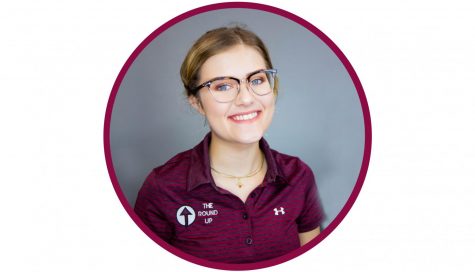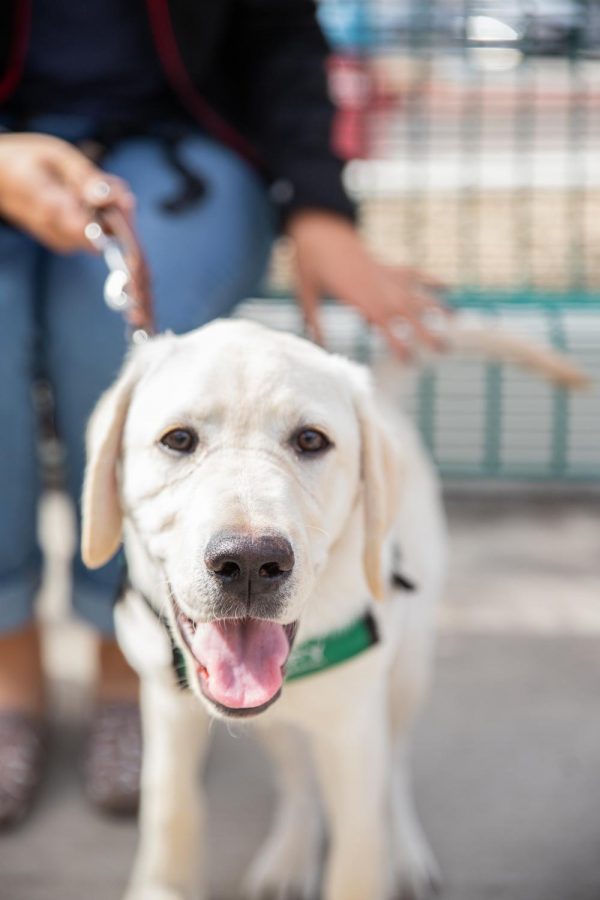NMSU Community Puppy Raisers Club partners with non-profit to train seeing-eye dogs
Scooby, a yellow labrador, is in training to be a guide dog for the blind.
Editor’s Note: Earlier versions of this story stated that the puppies could “fail formal training.” This has since been corrected to say that the guide dog path is not suitable for some dogs. The Community Puppy Raisers club does not consider any of the puppies to be failures because they will change a life in some capacity.
The New Mexico State University Community Puppy Raisers club partnered with the California-based Guide Dogs for the Blind, a non-profit organization that trains seeing-eye dogs to assist the blind and vision impaired throughout the United States and Canada.
CPR is the only club of its kind in New Mexico and has been based on NMSU’s campus for a year. The club itself receives funding from The Associated Students of NMSU, but membership is not exclusive to NMSU students. High school students from Arrowhead Park Early College High School and Las Cruces High School are also involved.
Members of CPR are either puppy-sitters or puppy-raisers. The puppy-raisers are given 10-week-old puppies by Guide Dogs for the Blind that they must take care of and train around the clock for about a year.
Puppy-raisers and NMSU sophomores Fisher Easley Smith and Christina Meechan are co-raising a 19-week-old puppy, Scooby. The pair agreed that raising guide dogs is “amazing” and “super fun,” despite being frustrating at times.
“You just have to remind yourself that this is for a better cause, something bigger than yourself,” Easley Smith said.
While the puppy-raisers are committed to training their dogs around the clock, there are times when they are out of town or must go somewhere they cannot bring their dog. This is when the puppy-sitters can take care of raisers’ dogs for a while.
“Say I have a lab, and [Scooby] can’t go to lab with me, so I call the puppy-sitter and [say] ‘Hey, are you able to watch him from two until our meeting tonight?’” Meechan said.
After the dogs have been trained by the club’s puppy-raisers, they are sent to formal training in California for roughly two months. From there, the dogs can be taken in as seeing-eye dogs by the vision impaired.
In the case that a dog decides “the guide dog path was not for them,” they may be “career changed.” This means they would no longer be trained as seeing-eye dogs, but as another type of service dog such as diabetic alert dogs and PTSD service dogs.
“If that dog just goes ‘working life is not for me,’ [Guide Dogs for the Blind] career change them and give them the opportunity to have a good life, the life that they want,” Easley Smith said.
Easley Smith and Meechan said having a club like CPR on campus provides learning opportunities for faculty and students who are unfamiliar with service dogs. Meechan said she gets stopped by people on campus multiple times a day who want to pet Scooby, but she has to tell them he is working.
“They have follow-up questions like ‘what’s he learning to do?’ and ‘what’s the club?’ so it’s a great opportunity for NMSU students, faculty and staff to learn,” Meechan said.
Everyone is welcome to attend CPR meetings, not just NMSU students, and there is no specific degree requirement to be a member. CPR is in the Tejada Building on NMSU’s main campus. Meetings are on Mondays from 6:30 p.m. to 8 p.m. in the FIDO Lab. They also accept donations to help with the costs for food, toys and equipment.

Jensen Stell is a second-year staff writer for The Round Up. She began as a staff writer her freshman year at NMSU. She focuses her reporting on the arts...


Karyn Nelson • Sep 18, 2020 at 9:03 AM
Do you know if they are still doing this? If so can you please contact me with their contact info. I am interested in participating.